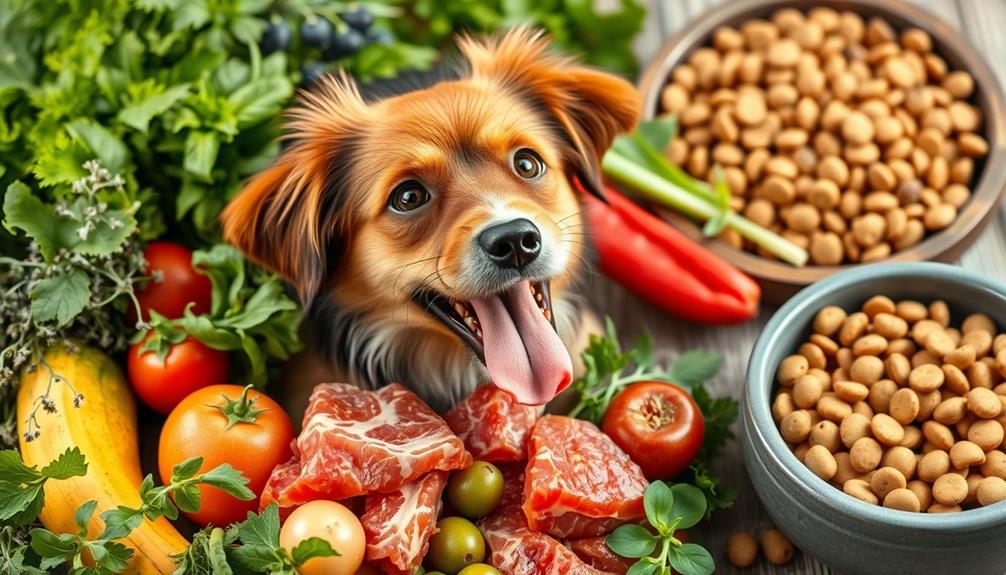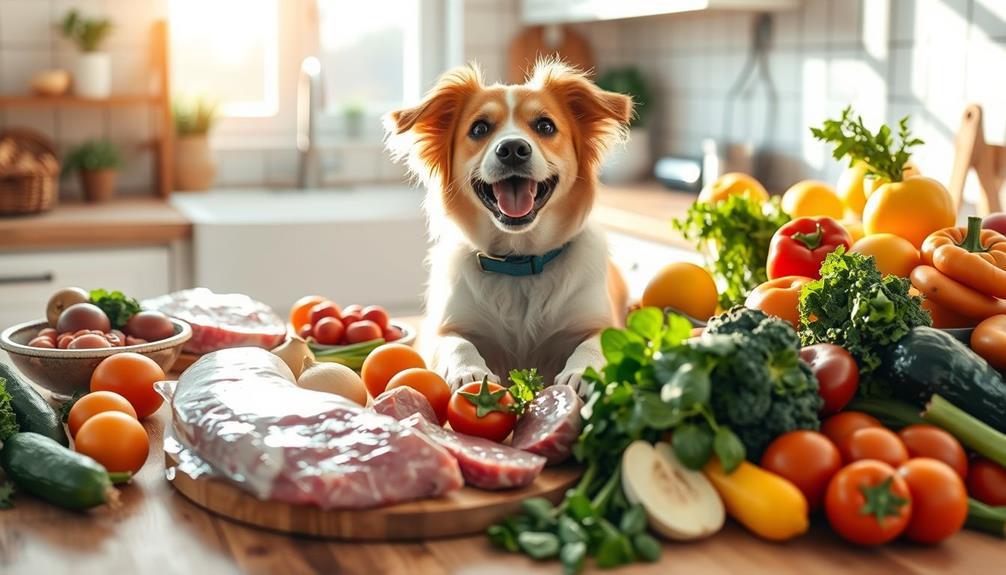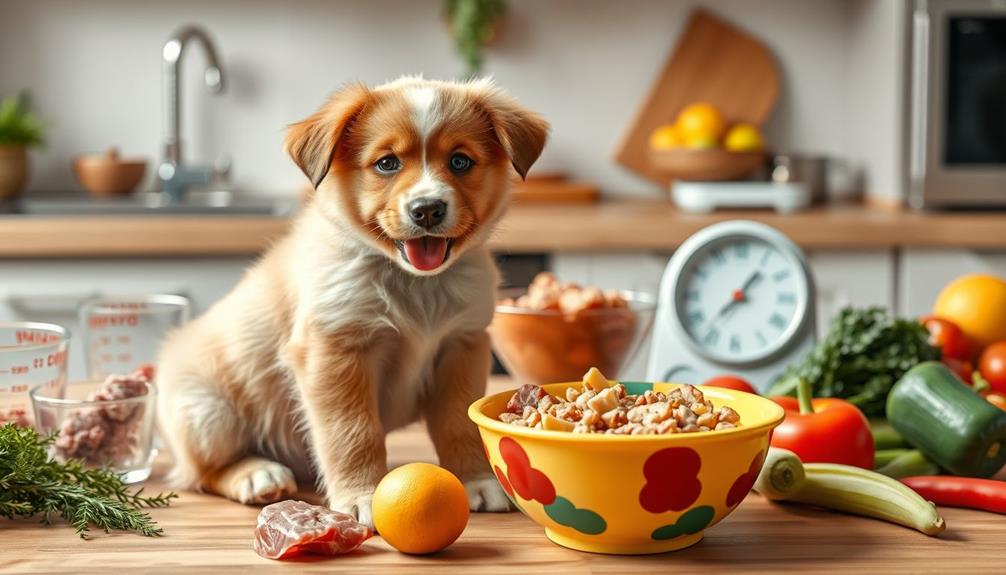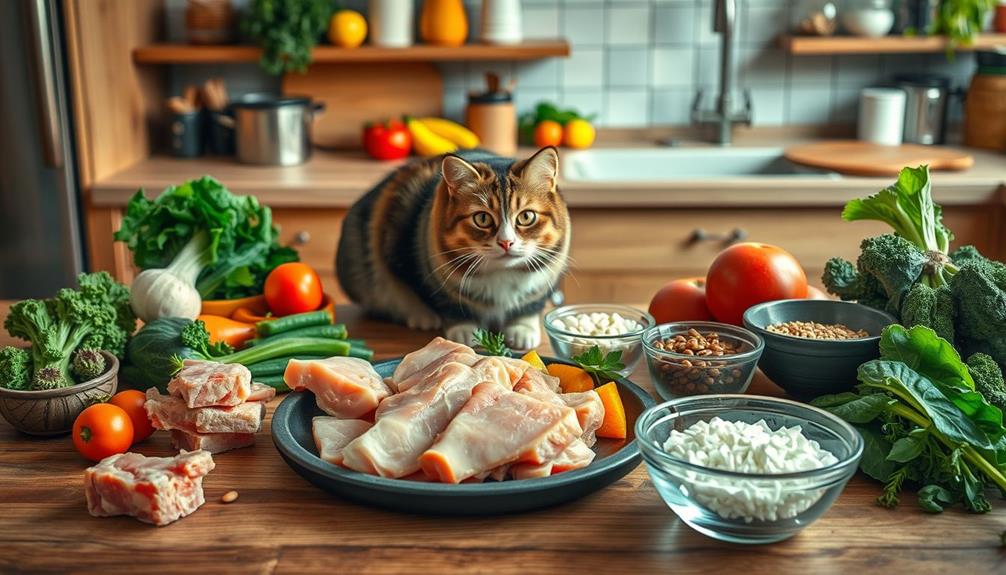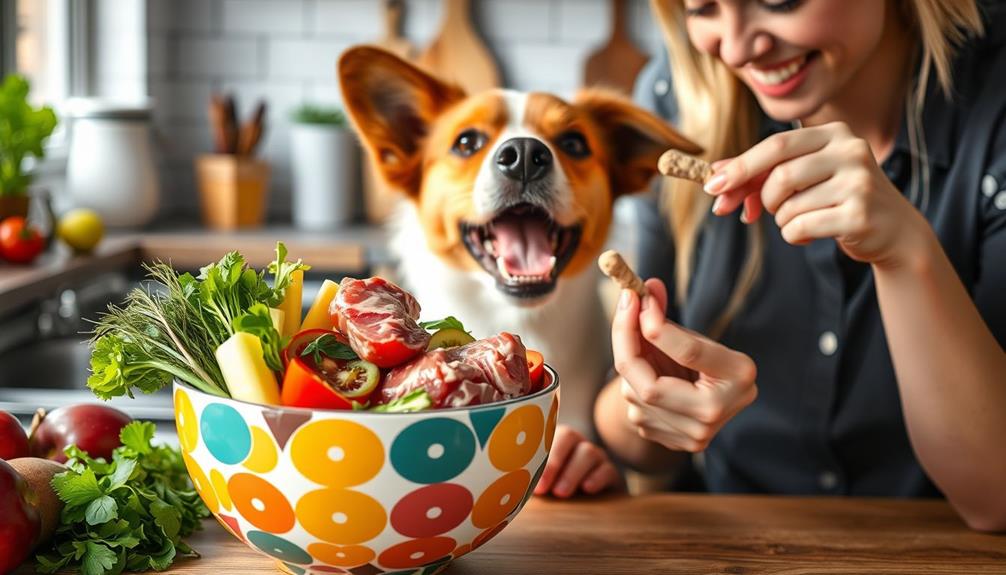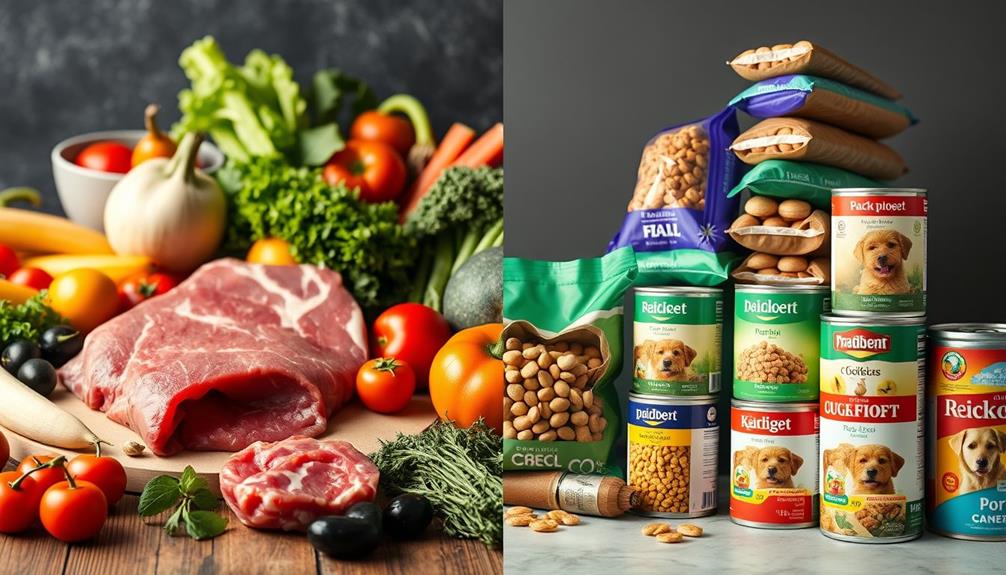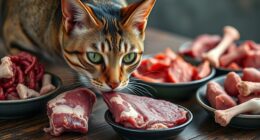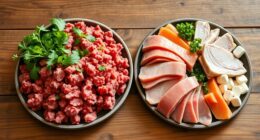A raw food diet for dogs can provide benefits like improved coat health and increased energy. However, it also carries risks, such as bacterial contamination and nutritional deficiencies. You might find that while raw diets can enhance liveliness, they can also pose challenges, especially for certain health conditions or life stages, like puppies. It's essential to consult your vet to guarantee the diet is balanced and safe for your dog. With careful planning and good hygiene practices, you can manage some risks. If you want to explore more details about this diet's impact, there's plenty more to uncover. When it comes to raw food and dog weight gain, it’s important to monitor your pet’s body condition closely. While some dogs may thrive on a raw diet and maintain a healthy weight, others may struggle to maintain a balanced weight. This is another reason why regular check-ins with your vet are crucial to ensure your dog’s dietary needs are being met.
Key Takeaways
- A raw food diet can improve coat health, energy levels, and nutrient absorption, but requires careful planning for nutritional balance.
- Risks include bacterial contamination from pathogens like Salmonella and E. coli, which can affect both dogs and humans.
- Nutritional deficiencies may occur, particularly in homemade diets, necessitating supplementation and veterinary consultation.
- Raw diets may not suit all dogs, especially those with health issues or specific life stages like puppies and older dogs.
- Veterinary organizations generally advise against raw diets due to the potential health risks and the need for tailored dietary recommendations.
Definition of Raw Food Diet
A raw food diet for dogs, often called the BARF diet, emphasizes feeding your canine companion a diet that mirrors what their ancestors ate. This diet typically includes raw meat, meaty bones, organs, fruits, and vegetables, aiming for a nutritional balance that supports your dog's health.
The idea behind feeding raw diets is to replicate the natural eating habits of wild canines, which proponents believe can lead to benefits like improved energy levels, healthier skin, and shinier coats. Additionally, understanding the importance of a balanced diet is essential, as it can help prevent potential health issues related to nutritional deficiencies, similar to proper diet guidelines for pets that emphasize a variety of nutrients.
However, it's essential to approach this diet with caution. Critics warn that without proper planning and guidance, you might inadvertently create nutritional deficiencies in your dog's diet.
Essential vitamins and minerals could be lacking, which can lead to health issues over time. To avoid this, you should consult with a veterinarian before making any dietary changes. They'll help you understand your dog's specific nutritional needs, ensuring that the raw food diet is appropriate for them.
Changing to a raw food diet requires careful consideration, but with the right information and support, you can make informed choices for your furry friend's well-being.
Components of Raw Diet
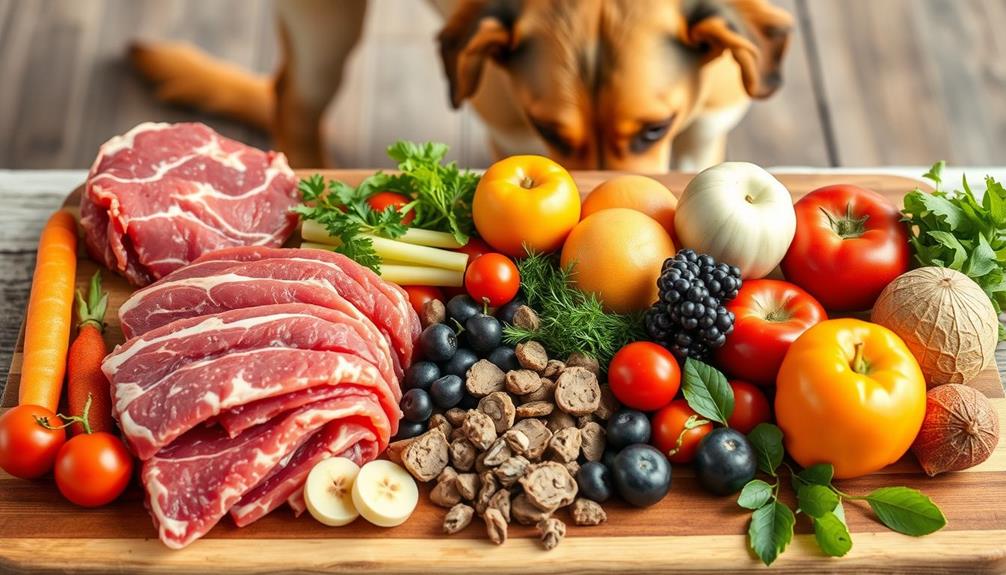
Understanding the components of a raw food diet is vital for ensuring your dog's nutritional needs are met. A balanced raw food diet typically includes raw meat, meaty bones, organ meats, fruits, and vegetables. These components work together to provide the necessary nutrients for your dog's health.
To achieve nutritional balance, it's important to evaluate the ideal calcium to phosphorus ratio, which should be around 1.4:1. This ratio supports bone health and is primarily sourced from raw bones. However, many homemade raw diets often lack scientific formulation, leading to potential deficiencies in essential nutrients like vitamin E, zinc, and iodine.
To help you better understand the various components, here's a simple breakdown:
| Component | Purpose |
|---|---|
| Raw Meat | Provides protein |
| Meaty Bones | Source of calcium and phosphorus |
| Organ Meats | Rich in vitamins and minerals |
| Fruits & Vegetables | Fiber and antioxidants |
Potential Health Benefits

When you switch your dog to a raw food diet, you might notice an improvement in their coat health, leading to a shinier and healthier appearance.
Many owners also report increased energy levels, thanks to the high protein content that supports muscle strength and vigor.
These benefits can make a noticeable difference in your dog's overall well-being.
Improved Coat Health
Many dog owners notice a remarkable improvement in their pets' coat health when switching to a raw food diet. The higher levels of essential fatty acids found in raw diets, especially from sources like fish oil, play a significant role in promoting a shinier coat and healthier skin.
These fatty acids, including omega-3 and omega-6, help enhance coat quality while reducing inflammation, which supports a robust skin barrier. Additionally, just like the benefits of antioxidants for overall health, the nutrients in a raw food diet can positively influence your dog's skin condition.
Furthermore, the high protein content in raw diets contributes to better muscle strength and overall body condition, further impacting your dog's coat appearance. Fresh ingredients in these diets provide essential vitamins and minerals that can reduce shedding and irritation.
As a result, many dogs experience a noticeable reduction in dullness and dryness.
However, it's vital to guarantee that the raw diet you choose is nutritionally balanced. Deficiencies can negatively impact coat health, so working with a veterinarian or a pet nutritionist can help you create a diet that meets all your dog's needs.
Increased Energy Levels
After noticing improvements in coat health, you might also find that your dog exhibits increased energy levels on a raw food diet. Many proponents attribute this boost to the high protein content in raw meats, which can support muscle development and overall health.
In addition, the digestibility of raw diets may enhance nutrient absorption, similar to the benefits noted in cold medications overview. Studies suggest that dogs consuming raw diets show enhanced stamina and endurance, making it a great option for active pets.
You may witness your dog displaying:
- A zest for life during playtime
- Greater enthusiasm on walks or runs
- Improved agility in activities
- A more playful demeanor at home
- Enhanced focus during training sessions
These changes often stem from the raw food's digestibility, allowing dogs to absorb essential nutrients more effectively than they'd from kibble.
Moreover, this diet closely mirrors the ancestral eating habits of canines, promoting better metabolic efficiency. As you observe these increased energy levels, it becomes clear that a raw food diet may be beneficial for your dog's health and overall happiness.
Risks and Concerns
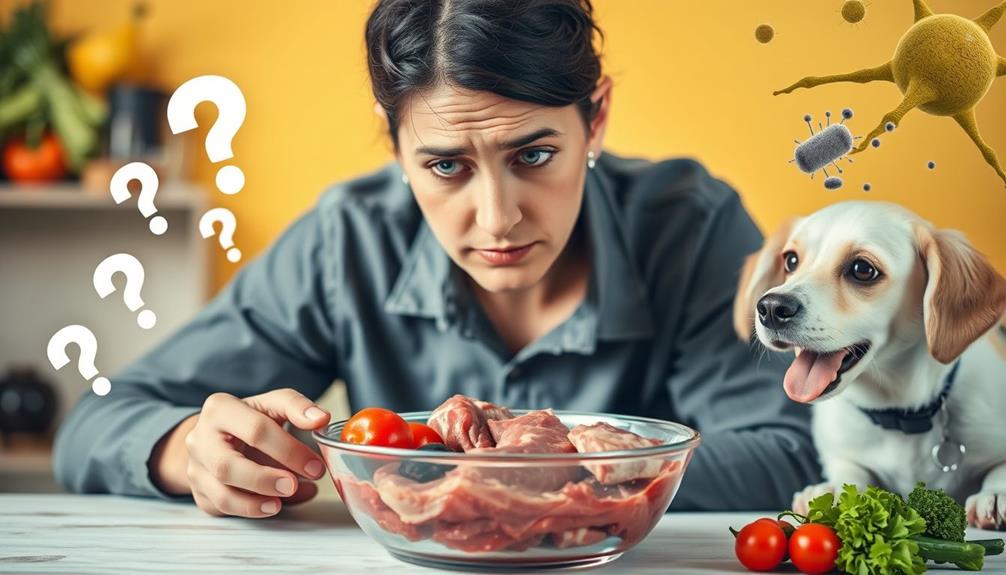
When considering a raw food diet for your dog, be aware of the potential risks, particularly bacterial contamination.
Many raw food samples test positive for harmful pathogens that can affect both dogs and humans.
Moreover, the high-fat content in some raw diets can lead to obesity and related health issues, similar to the risks associated with excessive ice cream consumption.
Additionally, an unbalanced diet can lead to serious nutritional deficiencies, impacting your dog's overall health.
Bacterial Contamination Risks
Choosing a raw food diet for your dog can come with serious bacterial contamination risks that you need to be aware of. Research shows that nearly 25% of raw dog food samples test positive for harmful bacteria like Salmonella and E. coli. This poses significant health risks not just to your pet, but to you and your family as well.
It's vital to be vigilant about essential oils for disinfecting surfaces that come into contact with raw food. Here are some key concerns to keep in mind:
- Salmonella: Can be carried by dogs without showing symptoms, increasing transmission risk.
- E. coli: Common in raw food, it can lead to severe gastrointestinal issues.
- Listeria monocytogenes: Linked to over 1,600 cases of listeriosis annually, particularly dangerous for immunocompromised individuals.
- Hygiene Importance: Handling raw dog food requires strict hygiene practices like thorough handwashing and sanitizing surfaces.
- Freezing Limitations: While freezing can reduce bacterial loads, it doesn't eliminate all pathogens.
Nutritional Deficiencies Concerns
Many dog owners may not realize that a raw food diet can lead to significant nutritional deficiencies. Vital vitamins and minerals such as vitamin E, zinc, and iodine can be lacking, potentially requiring supplementation. Homemade raw diets often fail to provide a proper balance of nutrients, which can lead to severe health issues like nutritional osteodystrophy.
Here's a quick look at common deficiencies in raw food diets:
| Nutrient | Concern |
|---|---|
| Calcium | Vital for bone health |
| Phosphorus | Needs to balance calcium |
| Vitamin E | Important for immune function |
| Zinc | Supports skin and coat health |
The ideal calcium to phosphorus ratio for dogs is approximately 1.4:1, but many raw diets don't achieve this, risking bone health, particularly in puppies. Nutritional imbalances can manifest as gastrointestinal upset or stunted growth. Consequently, it's essential to consult with veterinarians or pet nutritionists to guarantee your dog's health isn't compromised by these nutritional deficiencies in raw food diets.
Veterinary Perspectives
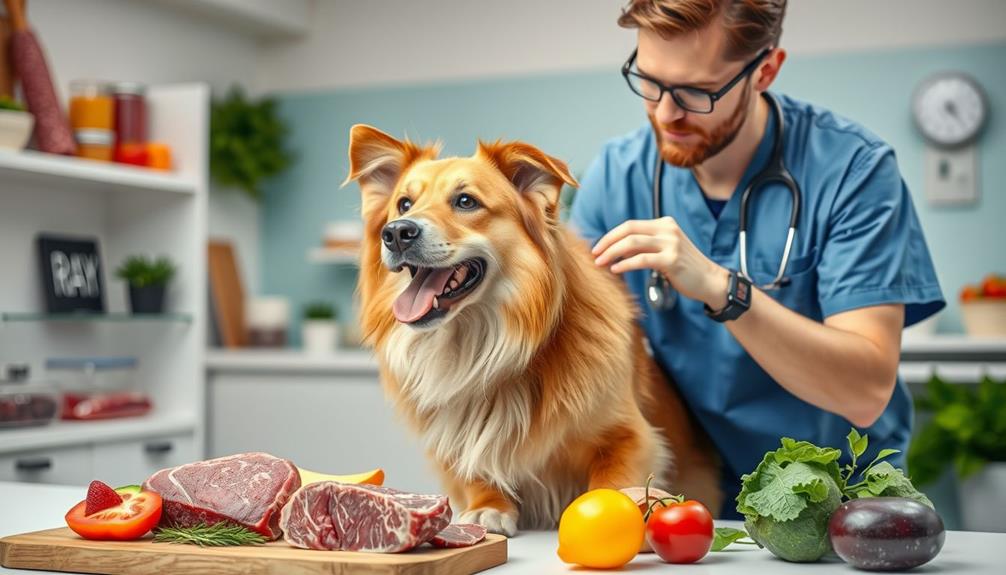
Veterinary perspectives on raw food diets for dogs reveal significant concerns that pet owners should consider. Major veterinary associations, like the American Veterinary Medical Association, strongly advise against raw food diets due to the lack of scientific backing and potential health risks.
Additionally, pet owners should be aware that implementing a balanced diet rich in vital nutrients is essential for overall health, as noted in effective strategies for weight loss. Here are some key points to keep in mind:
- Nutritional deficiencies can arise from improperly balanced raw diets.
- Contamination risks are high, with raw food often harboring pathogens like Salmonella and Listeria.
- Veterinary advice is important before making any dietary changes, as individual health conditions vary.
- Homemade raw diets frequently lack scientific formulation, leading to imbalances.
- Health issues, such as osteodystrophy, have been linked to raw feeding practices.
Given these factors, it's important to consult with your veterinarian before altering to a raw food diet. They can help you understand the specific needs of your dog and provide guidance on maintaining a balanced diet.
Nutritional Balance Essentials
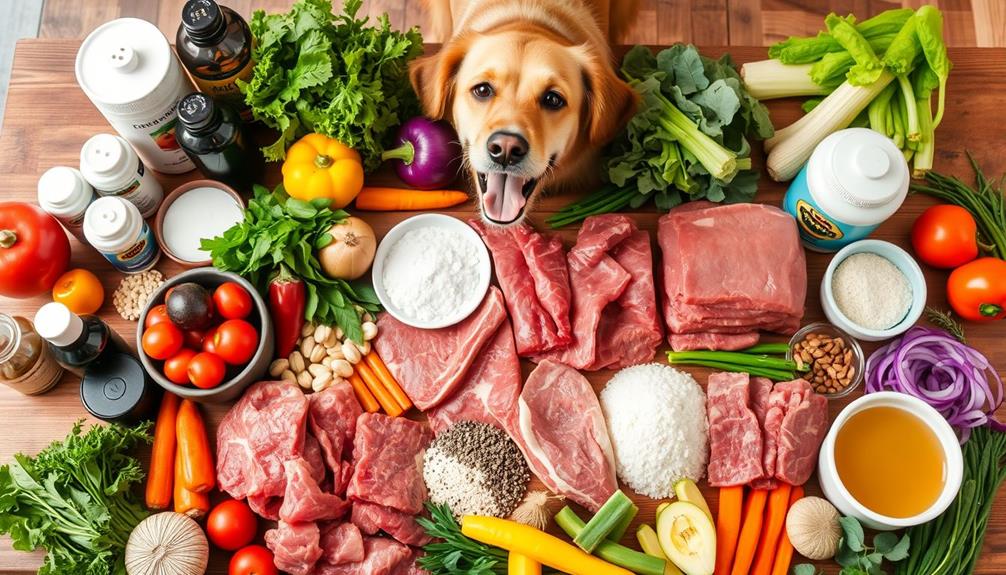
When it comes to feeding your dog a raw food diet, achieving nutritional balance is vital for their health and well-being. You need to guarantee that your dog gets all the necessary vitamins and minerals, like vitamin E, zinc, and iodine. Deficiencies in these can lead to serious health problems, so consider supplementation if needed.
Additionally, a well-structured budget for your pet's food can help you manage expenses effectively, making sure you can provide high-quality ingredients for your dog's diet effective financial management.
A balanced diet must also maintain the proper calcium to phosphorus ratio, ideally around 1.4:1. Raw bones can be a primary calcium source, so include the right bone content in your homemade meals. However, many pet owners don't use scientifically formulated recipes, which raises the risk of nutritional imbalances.
To effectively meet your dog's nutritional needs, diversify the ingredients you use. Relying on a single type of meat won't provide all the nutrients your dog requires.
It's essential to consult with a veterinarian or a veterinary nutritionist to tailor your dog's raw diet. They can guide you in creating a balanced diet that addresses any specific health conditions your dog may have, ensuring they thrive on their new eating plan.
Preparation Methods
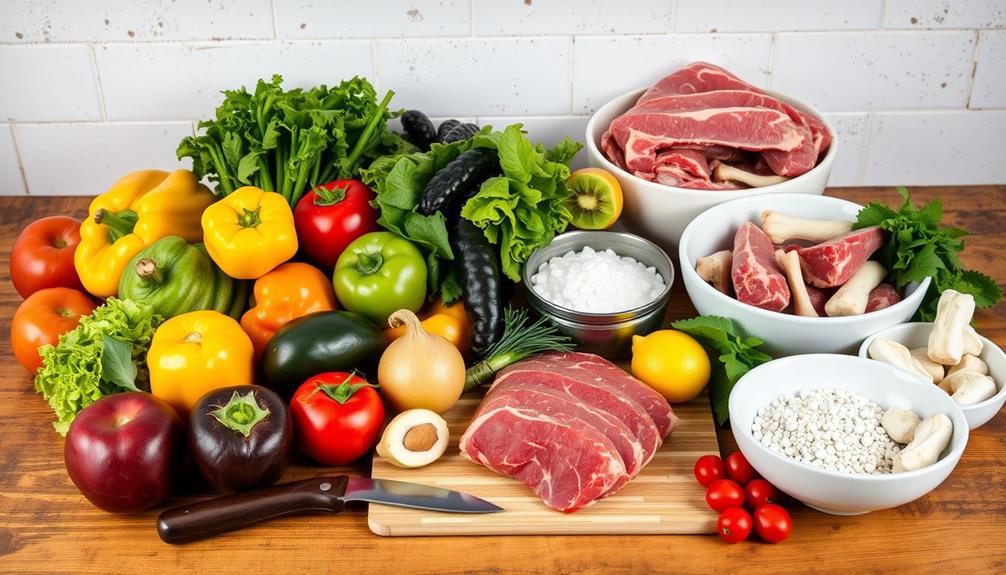
Preparing raw food for your dog requires careful attention to detail to secure a balanced diet. When evaluating homemade raw diets, it's important to focus on preparation methods that guarantee ideal nutritional value. This process can be time-consuming, but it's significant for your dog's health.
Additionally, it's necessary to take into account the use of essential oils for skin conditions in case your dog experiences any skin issues, as some oils can provide relief when used appropriately.
Here are some key elements to include in your raw food preparation:
- Fresh meats: Select high-quality cuts from reliable sources.
- Organ meats: Incorporate liver and kidneys for important vitamins.
- Vegetables and fruits: Use dog-safe options like carrots and blueberries for added nutrients.
- Raw, meaty bones: Serve these to provide calcium and promote dental health.
- Supplements: Enhance the diet with vitamin E and fish oil for overall well-being.
Consulting with a veterinarian or a pet nutritionist can help you develop a balanced homemade raw diet, confirming it meets your dog's specific needs.
Remember, maintaining the proper calcium to phosphorus ratio is crucial for bone health, so don't overlook this aspect while preparing meals.
With dedication and the right preparation methods, you can provide a nutritious raw food diet that supports your dog's well-being.
Safety and Hygiene Practices
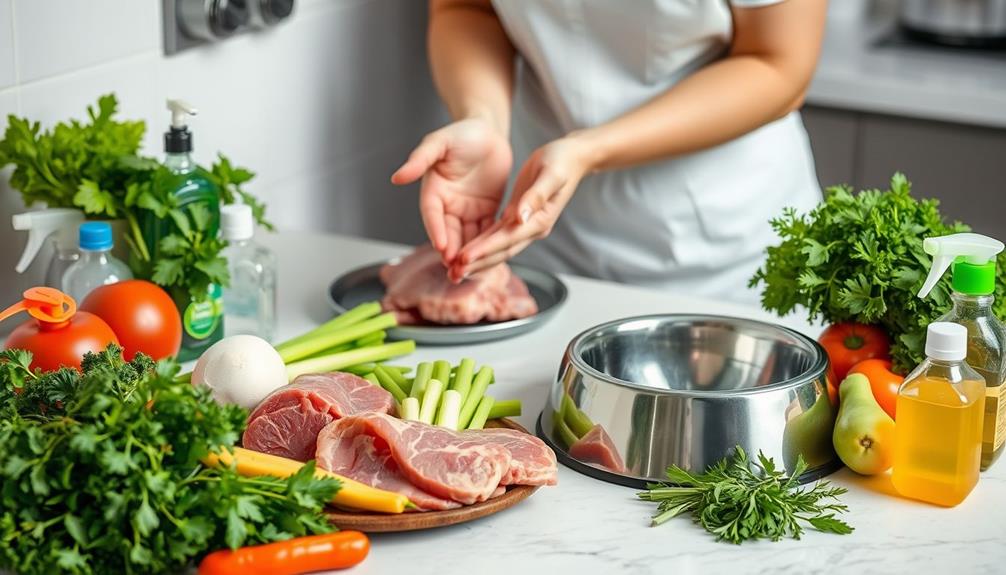
Ensuring safety and hygiene is essential in maintaining your dog's raw food diet. Proper handling practices help minimize the risks associated with harmful bacteria, such as Salmonella and Listeria monocytogenes, which can be present in nearly 25% of raw food samples.
To protect both you and your dog, always wash your hands thoroughly after handling raw food and clean surfaces to prevent cross-contamination. Additionally, keeping air quality considerations in mind, like using an air purifier, can help reduce airborne contaminants in your home environment.
It's vital to store raw food in the freezer until you're ready to use it. When thawing, do so in the refrigerator or microwave, and always keep raw food separate from other food items to avoid contamination.
Use separate dishes for your dog's raw meals, and cover any leftovers properly to maintain hygiene and inhibit pathogen growth.
If your household includes vulnerable individuals, like young children or those with compromised immune systems, exercise extra caution with raw meat diets.
Market Trends in Raw Feeding
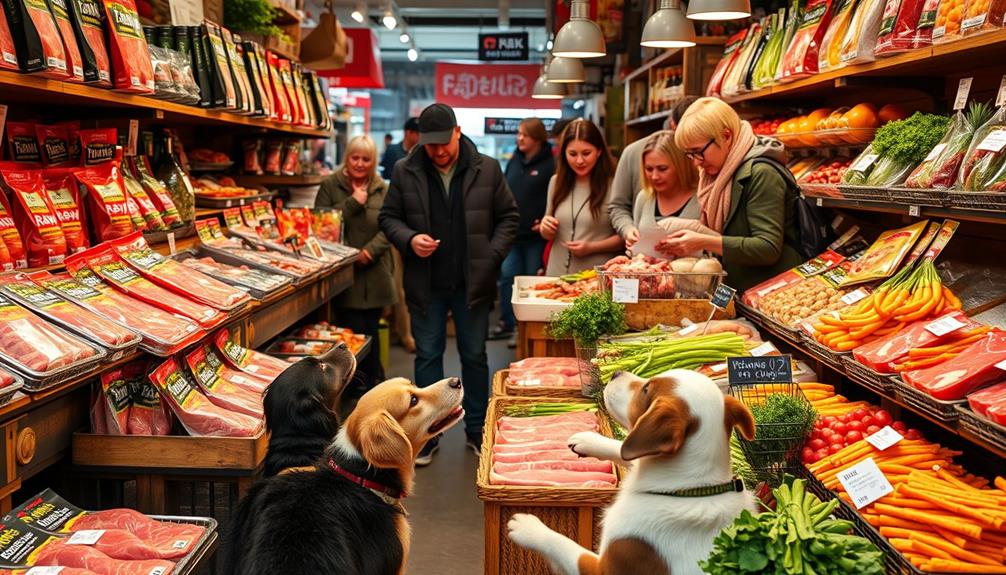
After establishing safe handling and hygiene practices for raw feeding, it's important to look at the market trends surrounding this dietary choice.
The commercial raw pet food market is valued at $169 million, which, while a niche, shows a growing interest in raw diets. Sales have surged by 15% annually, and projections indicate a remarkable growth rate of 23% in the coming years.
The increasing popularity of best websites to earn money online may also parallel the rise in pet care trends, as more individuals seek natural and health-oriented choices for their pets while managing their finances.
Here are some key trends you might find interesting:
- Rising awareness: More pet owners are learning about the benefits of raw diets.
- Safety concerns: The 2007 Pet Food Recall has pushed consumers toward homemade and commercial raw options.
- Pet owner demographics: An estimated 15-25% of dogs and 10% of cats are now on some form of raw diet.
- Health-conscious choices: Shoppers are increasingly prioritizing natural feeding practices for their pets.
- Market share: Although raw diets represent under 1% of North American pet food sales, their growth reflects changing consumer behaviors.
These trends indicate a shift towards more natural feeding practices, driven by health concerns and a desire for higher-quality nutrition for pets.
Suitability for Different Dogs
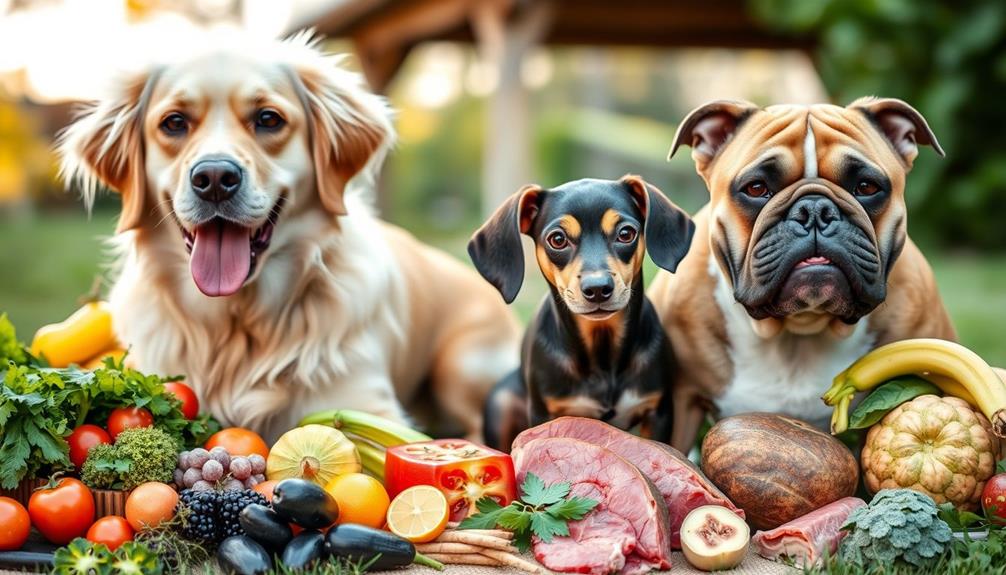
When considering a raw food diet for your dog, it's vital to recognize that not every canine will thrive on this type of nutrition. The suitability of a raw diet largely depends on individual health conditions.
For instance, dogs with kidney or liver issues may not benefit from the high protein content typical of raw diets. Puppies also require careful consideration; their developing bones can be negatively impacted by improper calcium and phosphorus ratios, making a raw diet risky without proper planning.
On the other hand, dogs with food allergies or sensitivities might find relief through a limited ingredient raw meat-based diet, which can help minimize allergic reactions.
If you have a senior dog with existing health concerns, be cautious; they may not tolerate high protein or raw diets well. It's important to consult your vet for tailored dietary recommendations based on your dog's unique needs.
Ultimately, you should weigh your dog's overall health, breed, age, and individual nutritional requirements. Always seek vet guidance before changing to a raw food diet, ensuring that it's the right fit for your furry friend.
Frequently Asked Questions
Why Don't Vets Recommend a Raw Diet?
Vets don't recommend raw diets because they pose significant health risks, like bacterial contamination and nutritional deficiencies. They emphasize consulting a professional before making dietary changes, ensuring your dog's health and safety remain a priority.
What Are the Disadvantages of Raw Food Diet for Dogs?
Raw food diets can lead to choking hazards, bacterial infections, and nutritional deficiencies. You'll find preparation time-consuming and costly, plus high protein levels might worsen certain health conditions in your dog. It's essential to evaluate these risks.
Do Dogs Do Better on a Raw Diet?
You might notice your dog showing improved energy and healthier skin on a raw diet. However, it's crucial to take into account individual responses, potential risks, and the lack of scientific backing before making any dietary changes.
Is There Any Science Behind Raw Diets?
Studies show up to 25% of raw dog food samples can harbor dangerous bacteria like Salmonella. While some promote raw diets, there's limited scientific evidence backing their benefits compared to commercially prepared foods. Stay informed!
Conclusion
To sum up, while a raw food diet can offer incredible health benefits for some dogs, it's not a one-size-fits-all solution. You'll need to weigh the pros and cons carefully and consider your dog's unique needs. Always consult with your vet before making any drastic changes. Remember, the right diet can make your pup feel like a superhero, but the wrong one could lead to serious issues. Choose wisely for your furry friend's well-being!

